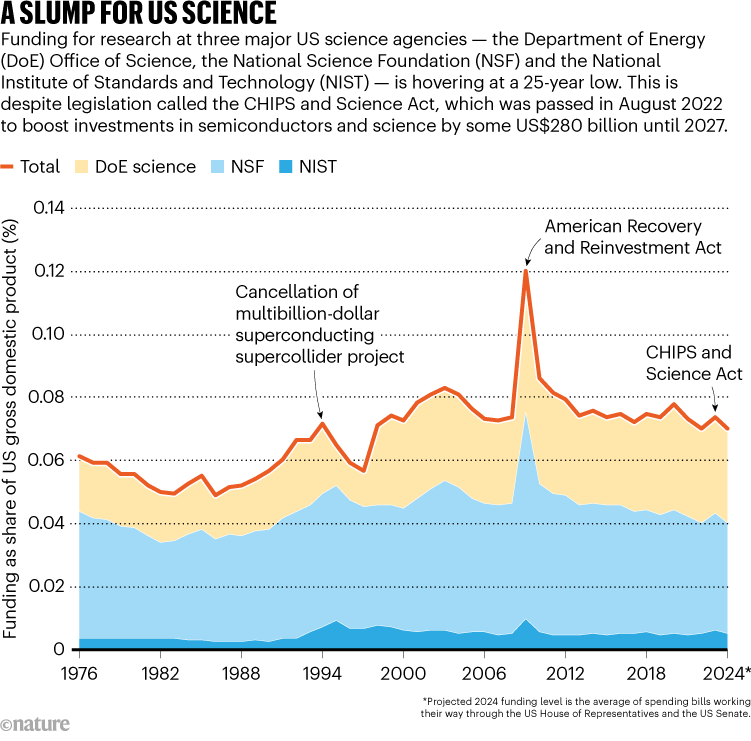Last year, lawmakers in the United States passed bipartisan legislation intended to maintain US competitiveness with countries such as China by boosting funding for science and innovation. But concerns are mounting that the US Congress will fail to deliver on its promises.
The money allotted to a handful of major US science agencies that had been targeted for a budget boost is likely to fall short of the legislation’s goals by more than US$7 billion in 2024, according to a report. And overall funding for those agencies will continue to hover at a 25-year low (see ‘A slump for US science’).
“We’re leaving scientific opportunities on the table,” says Matt Hourihan, who led the analysis for the Federation of American Scientists, an advocacy group based in Washington DC. “If we drop this ball, others will be happy to pick it up.”

It was precisely this fear that drove members of Congress to come together to pass the CHIPS and Science Act of 2022. The legislation promised one of the largest increases in US science funding in a long time, totalling some $280 billion over five years. Much of the spending mandated by the bill was focused on semiconductor research and manufacturing — areas in which other countries, particularly China, have dominated. Lawmakers also authorized investments in other science and innovation programmes, but these were not mandated, and need to be approved by Congress during an appropriations process each year.
That process has become increasingly contentious as political polarization in the United States has risen over the past few decades. Disputes about overall spending levels and funding for various social programmes have led to repeated delays in crafting the annual budget, at times forcing the government to shut down. This year is a prime example: Republicans, who control the US House of Representatives, blocked legislation that would have allowed the government to increase the federal debt limit and pay its bills, until they were able to secure an agreement with the Democrats in May to limit spending. And last month, a handful of extreme right-wing Republicans sought to close the government down as they pushed for further spending cuts.
Coming up short
The CHIPS act authorized three agencies — the National Science Foundation (NSF), the US Department of Energy (DoE) Office of Science and the National Institute of Standards and Technology (NIST) — to receive a total of $26.8 billion in the fiscal year 2024. Together, these agencies fund much of the basic and applied research in core areas targeted by the legislation, including advanced computing, manufacturing, climate change and national security. As it stands, however, appropriations bills pending in Congress mean that these agencies are likely to receive only a little more than $19 billion next year — a shortfall of around 28%, according to the Federation of American Scientists.
Biden calls for boosts in science spending to keep US competitive
This decrease would add to an existing downward trend in funding for these agencies. Measured as a share of the US gross domestic product (GDP), overall funding for the NSF, the DoE Office of Science and NIST has been declining for more than two decades, with the exception of a one-time injection of cash from an economic stimulus bill in 2009.
The trend raises alarm and underscores the need for Congress to follow through on its commitments in the CHIPS and Science Act, says Jill Pentimonti, director of research advancement at the University of Notre Dame in Indiana, and a board member of the Science Coalition, which represents more than 50 US research universities. Failing to properly fund these and other science agencies, she says, “threatens to weaken our position as a global leader in innovation and stifle our economic growth”.
That’s not to say that the United States isn’t investing in science. The country still leads the world in absolute funding for research and development, when both public and private investments are factored in. It spends more than $700 billion annually, and that amount is on the rise, according to the American Association for the Advancement of Science (AAAS), in Washington DC. But although private investments are increasing, total government investments have declined from around 2% of GDP during the space race between the Soviet Union and the United States in the 1960s to about 0.7% of GDP today, says Joanne Carney, chief government-relations officer at the AAAS.
Billions more for US science: how the landmark spending plan will boost research
One reason that advocates for science worry about declines in public funding is the fact that such cuts tend to have a disproportionately strong effect on basic research. The private sector typically neglects this area because the pay-off — although potentially larger than that derived from applied sciences — is harder to predict.
Looking further afield, Carney says that many other countries are increasing their public funding for research, and expanding their investment in the science and technology workforce. That benefits science as a global enterprise, she says, but it also creates competition for talent and scientific advancements in many fields. If the United States wants to remain a leader, she adds, aspirational legislation such as the CHIPS and Science Act might not be enough.
“Our innovation system cannot thrive on policy language alone,” Carney says. Congress must follow through with “real and sustainable federal investments that mirror those very same goals and aspirations”.
…. to be continued
Read the Original Article
Copyright for syndicated content belongs to the linked Source : Hacker News – https://www.nature.com/articles/d41586-023-03135-x
